Opalite (Glass) (Synthetic)
An artificial glass, with an interesting iridescent effect. It is sometimes mis-sold as Opal or Moonstone, but it is not – it is a man made glass.
It is, as far as I can tell, almost always sold cast or polished. I cannot find rough ‘chunks’ available for sale anywhere.
Showing all 6 results
-
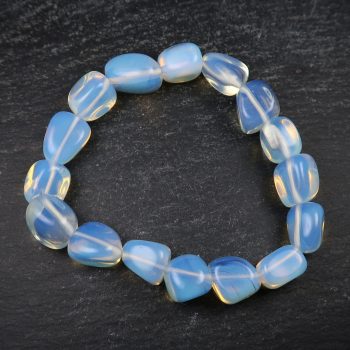
Opalite Bracelets (Glass)
£1.95 -

Opalite Cabochons (Glass)
Price range: £1.00 through £4.00 -
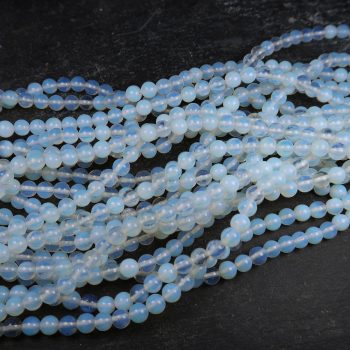
Opalite glass bead strands
Price range: £2.00 through £5.00 -
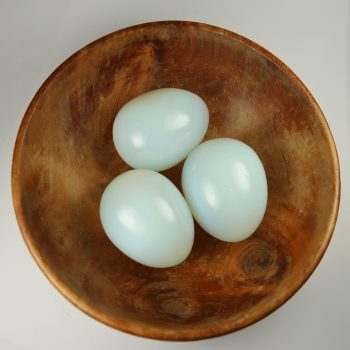
Opalite glass egg carvings
£2.50 -
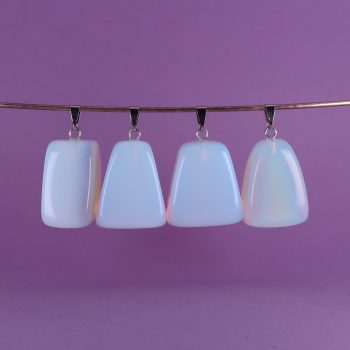
Opalite glass pendants
Price range: £1.00 through £2.00 -
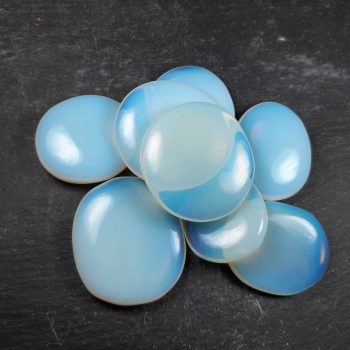
Opalite Palmstones
Price range: £2.50 through £3.00
Appearance, Uses and History
Opalite is a man made glass, a relatively clear white material. It is often mis-sold as Opal or Moonstone by unscrupulous sellers – and is probably one of the most common scams in this industry. We have written a fair amount about glass being used as a crystal or gemstone before…
There is very little actual information online regarding this glass, from reputable sources at least. This page contains the information I could find, with my own assumptions.
Uses
This glass is purely used as a decorative object, as far as I can tell. It is sold tumbled or carved, or cut and polished into other forms such as cabochons or beads. Due to its low price it is popular in costume jewellery.
History and Name
The name is a little unusual. It primarily refers to this glass, but has in the past been used to refer to low grade impure Opal.
It has also been used to refer to “Tiffany Stone”. To confuse matters more, there is a very similar looking type of glass referred to as Opaline Glass.
According to the Oxford Dictionary it was first used in the late 19th century, by the American geologist Albert H. Chester. Unfortunately I don’t have a copy of the book to check if it has any information on manufacture.
Somewhat confusing, to say the least… on this website we will only ever refer to this glass as ‘Opalite’.
This glass is sold under many names, most of which refer to other materials; not glass.
Argenon, Milk Glass, Moonstone, Opal, Opaline, Opal Moonstone, Opalised Fluorite, Opalised Glass, Opalized Glass, Rainbow Moonstone, Sea Opal, Tiffany Stone.
So… what is Opalite, anyway?
Frankly, it is quite hard to find any information on the manufacturing techniques used to make this glass.
There are many references to supposed manufacturing practices, but how accurate they are, we simply can’t say.
Some websites suggest the stone is a ‘glass resin’ mixed with metal film or powder, which creates the iridescent effect. Others suggest that this is cast glass with Fluorite dust mixed in.
Others say they may be cast glass with silica fragments scattered in the mix. Some say Dolomite is used. Some even say these pieces are ‘laser treated’ Quartz!
Evidently, there are no clear answers, and some people are likely to be spinning fiction about this glass for sales. Short of finding and visiting a manufacturer, this may be as good as we get.
Personally, I think the glass is cast with some diffusing or refracting particles or powders in the mix. I am not a materials engineer, however! There are a few similar glasses that have been used in recent times for art and decorative glass pieces – Sabino glass, and Fry glass being two that are very similar to Opalite.
This page contains some information about different types of Opalescent glass, and a ‘recipe’ – currently, that’s as close as I’ve gotten to finding out the truth.
One day, finances willing, I’d like to have some Opalite examined in a lab, and maybe cast some light on this mystery.
There are a few fairly simple tests that can be done to test a piece.
One easy test is to check whether the ‘stone’ has bubbles in it. Not every piece will, of course – but it is a clear indicator of glass.
This glass also shows something called the Tyndall Effect, which is a type of light scattering – essentially, the glass appears to be a blue-white colour, but when light shines through it, the light will be orange.
Locales
As a man-made glass, there are no locales for this. It is primarily manufactured in Asia, China especially.
Mineralogy
Hazards and Warnings
Particular hazards of this glass include the Silica dust associated with cutting or grinding it and the risk of cutting if it is broken.
Almost all rocks, minerals (and, frankly, almost all other substances on earth) can produce toxic dust when cutting, which can cause serious respiratory conditions including silicosis.
When cutting or polishing rocks, minerals, shells, etc, all work should be done wet to minimise the dust, and a suitable respirator or extraction system should be used.
Translations
Opalite glass is likely a trade name, and may not translate well to other languages.
Arabic:
- أوباليت
Hindi:
- ओपलाइट
- ओपलाइट ग्लास
Portuguese:
- opalita
Bengali:
- ওপালাইট
Indonesian:
Punjabi:
English:
- opalite
- opalite glass
- Argenon
- Milk Glass
- Opaline
- Opal Moonstone (a combination of two mineral names)
- Opalised Fluorite (a real, and unrelated mineral!)
- Opalised Glass
- Opalized Glass
- Sea Opal
- Tiffany Stone (a real, and unrelated mineral!)
Italian:
Russian:
- опалит
French:
Japanese:
Spanish:
German:
- Opalit
Korean:
- 오팔 라이트
Thai:
Gujurati:
Mandarin and Traditional Chinese:
Urdu:
Further Reading / External Links
- Wikipedia page: https://en.wikipedia.org/wiki/Opalite
- Mindat page: https://www.mindat.org/min-5984.html
- InVogueJewelry: I spoke briefly with Dawn, the owner, who has posted several good articles about this odd glass: https://invoguejewelry.blogspot.co.uk/search?q=opalite
- The Glass Museum page on Opalescent Glass: http://www.theglassmuseum.com/opalesc.htm
